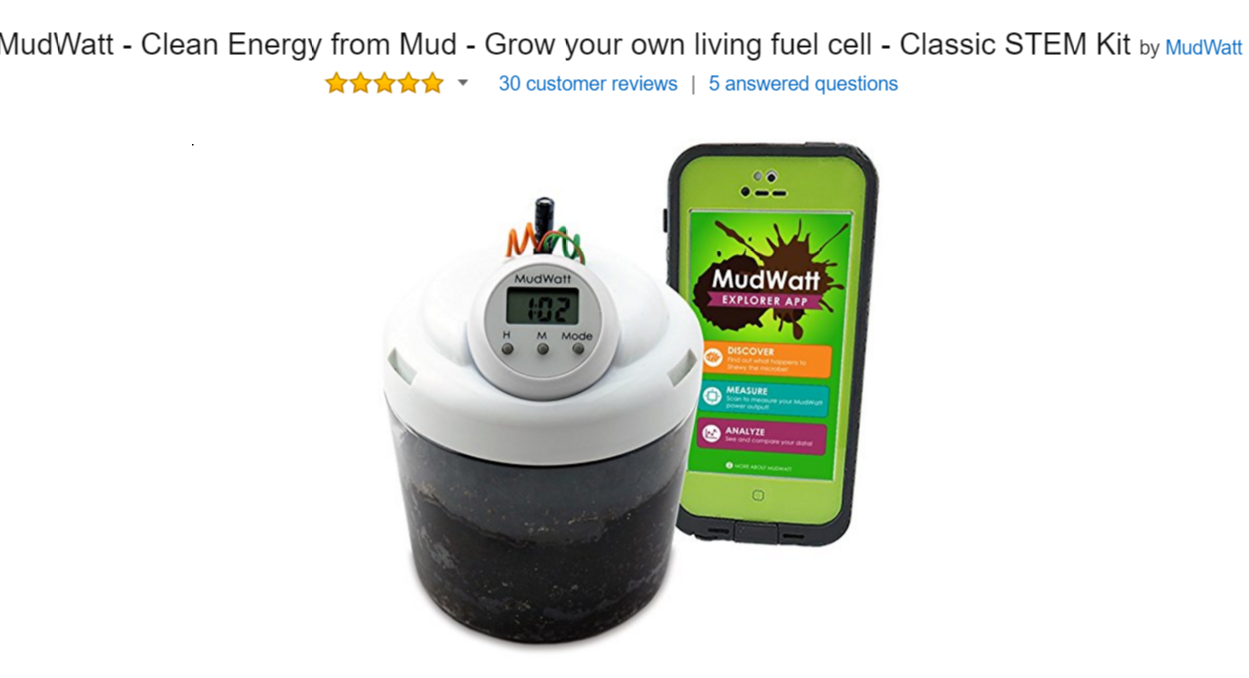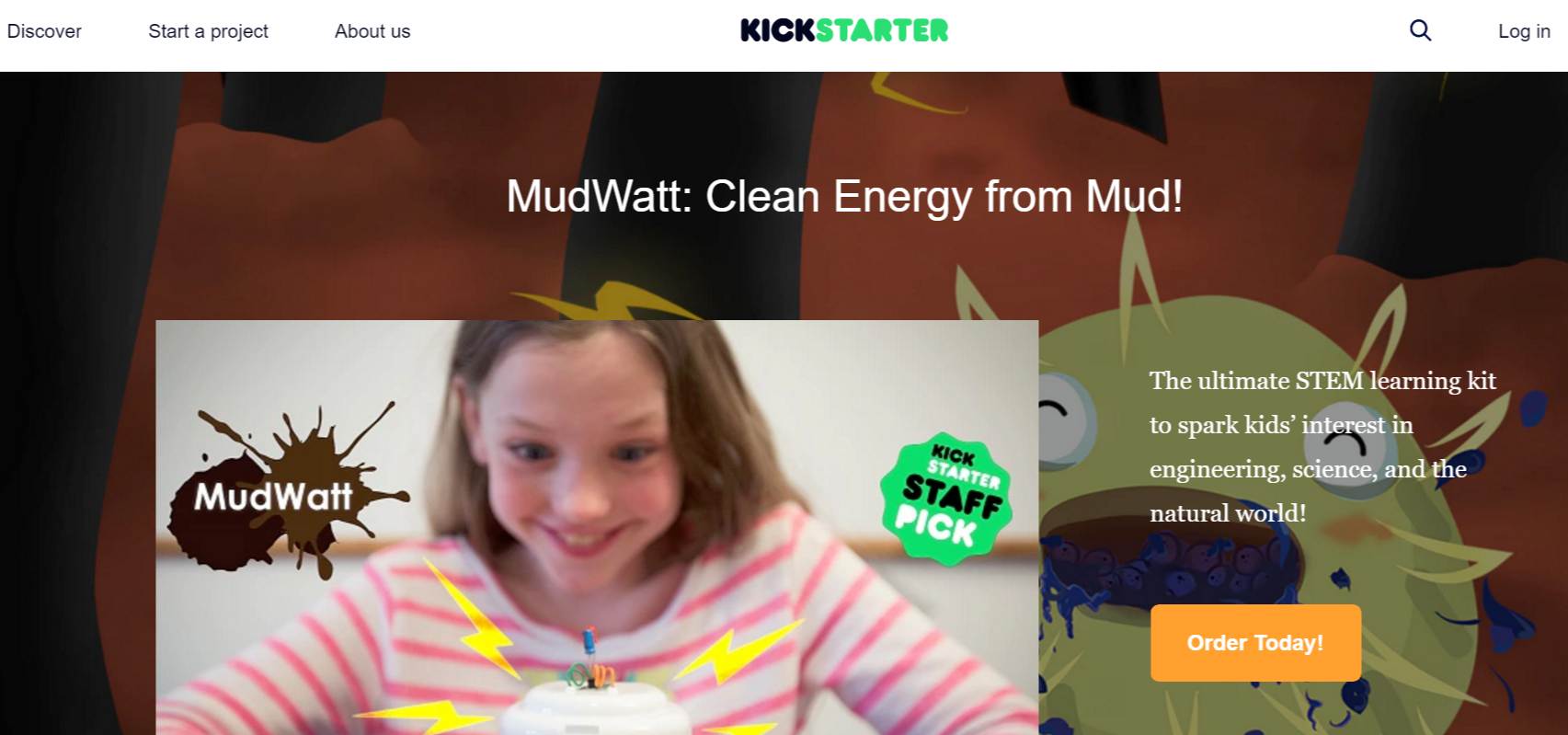From Startup to the Amazon Kickstarter Collection: Q&A With MudWatt


MudWatt is a science kit that has garnered the attention of not only teachers and parents, but also Forbes, Wired, and TechCrunch.
 After establishing capital on Kickstarter—an impressive $35,028 with 512 backers—MudWatt was picked up by Amazon’s Kickstarter Collection, a recent addition to the Amazon Launchpad program.
After establishing capital on Kickstarter—an impressive $35,028 with 512 backers—MudWatt was picked up by Amazon’s Kickstarter Collection, a recent addition to the Amazon Launchpad program.
We felt it was a prime opportunity (no Amazon pun intended) to sit down with Keegan Cooke, the Executive Director of MudWatt, to explore MudWatt’s growth from a Kickstarter newbie to an Amazon Kickstarter Collection featured product.
The MudWatt is a “living fuel cell powered by the micro-organisms naturally living in the soil beneath your feet.” The MudWatt kit includes everything it needs to function—from cathode to anode–all you have to do is set it up and add some dirt.
Here’s what the MudWatt looks like on Amazon:

Within 3-5 days, the microbes within the soil will start to release electrons which generate enough electricity to fuel a digital clock and LED, or track growth on the MudWatt Explorer App. The MudWatt comes in five different kits with varying tools, ranging from the Classic kit at $39.99 to the Classroom kit at $299.99.
If you want to get into the nitty gritty of MudWatt’s science, see How MudWatt Works.
“I never got into the science kits as a kid, I always thought they were pretty sterile and dry. I…didn’t like reading the content [either] because I thought it was pretty dry. I think the turning point for me and my business partner Kevin was in high school when our physics class teacher broke the rules a bit. After class, he taught Kevin and me how to build a potato cannon…using PVC pipes you would get from a hardware store.
We built our first potato cannon and started launching potatoes across football fields. I’m sure there was supposed to be some kind of physics lesson behind it, but that was kind of our first experience building something and having it be awesome.
We built more potato cannons after that, then started building bigger things, like a Catamaran out of PVC pipes and old tarp material, and that was a lot of fun. We had our maiden voyage on that catamaran in our local river, and it floated for about 30 seconds, then it sank, so there were some bugs to be worked on. [laughs]”
“At various points in MudWatt’s development, we used our user feedback to evolve the kit. Our users happen to be kids, so the experiences that the kids had played a major role in how the kit [evolved] in its design.
We’ve always taken the feedback of students into account, and they’ve learned things without us…kids will try out certain things in their MudWatts.

One of our users started shredding up the packaging [into little dime-sized pieces] and put that in the mud, and found that was a great fuel source. Now that’s one of our recommendations in the user manual because it’s such a good fuel source for the microbes.”
“If the fun aspect wasn’t there, I don’t think Kevin and I would keep doing this because we’re in hardware and education. It’s not a super lucrative market, so the ‘fun’ piece is a huge part of our work.
It’s a challenge to keep the [marketing fresh], because obviously, we’ve been doing this for a while. What’s good about [MudWatt] is that it is part of a new wave of research about the mix of biology and electronics—the interface between those—so the good news is there are news articles all the time of new research in this field, and we’re able to tie MudWatt into this news. That’s probably a big part of our marketing—promoting new research discoveries and tying MudWatt into it.

Another [reason we’re able to keep marketing fresh] is because the education market is in a flux right now. Until recently, educators never had any standards for science education. Now they have…NGSS—Next Generation Science Standards. It’s kind of a big departure from the way teachers used to teach science.
Now, teachers are encouraged to have interdisciplinary activities that mix a lot of different sciences, have open-ended projects where the outcome is unknown, and also have a mix of tangible experiences [while incorporating] apps and software. Just by chance, MudWatt hits all those [requirements], and teachers really like it—it helps them teach to NGSS standards.”
“We have two different types of customers—teachers and parents. For parents, Amazon has been…a huge selling channel, so we’ll continue to use the promotional tools available through Amazon—like the Lightning Deals, advertisements, and other promotions.”
For teachers, it’s a little different story. We go to conferences and put ads in catalogs. So far, that’s been the most effective way [to market to teachers]—really making that personal connection. The level of trust that a teacher needs with a vendor is higher than with a parent because they’re performing an activity with 30 students at a time.
They need to trust that not only will we supply them with the materials they need on time and in good condition, [but they also need to know] it’s going to be a good experience for their students, and that their students are going to learn something. All of that is easier to relay in person than through an ad.”
“We always did this as a side project, and sales grew over time through word of mouth, but we never did any outreach or sales activities.
We decided Kickstarter would be a good way of launching the MudWatt into the world, and we also wanted to have some capital up front to start a relationship with a manufacturer.
That was a big evolution step for us, where we were able to engage a manufacturer to help make the kits. Because until that point, we were still making them in my apartment.”
“It’s always a challenge [on Kickstarter] because you’re competing for attention with all these other cool projects. We tried to stick out and created a fun memorable video that people would want to share—even if those people weren’t [personally interested in the project].
We also used a service called Press Friendly–they’re a really nice service for contacting news outlets. It’s this automated system where you put together a press release using their template…and we got a lot more media attention than by doing it ourselves.”
There’s a lot of lessons learned in the Kickstarter program—[but in my opinion], the content and messaging of your program is much more important than the imaging quality of your video.
Honing your messaging will impact your fundraising abilities by about 10x whereas honing your photography and your videography probably only impacts the quality of your fundraising by about 2x. These are generalizations, but it’s the sense I got going through the process. If the messaging is right, the quality is a helpful [addition].

If you’re considering doing a crowdfunding campaign, really experiment and focus on the messaging, and if you have the budget, make a polished video. It’s not the most important thing.”
“We were an [Amazon] seller for some time—where [we owned and shipped our] products, but put our products on there to sell them.
 Then we switched to Fulfilled by Amazon, but we were still a seller. It wasn’t until did our Kickstarter that we changed our relationship with Amazon to a vendor relationship, and that coincided with the Launchpad program.
Then we switched to Fulfilled by Amazon, but we were still a seller. It wasn’t until did our Kickstarter that we changed our relationship with Amazon to a vendor relationship, and that coincided with the Launchpad program.
So the Amazon company started buying units from us, so they became owners of the units, and [they became] responsible for selling them. [Because of that,] Amazon had more incentive to sell [MudWatts], and so they tapped us into all of their marketing activities—different ads and articles like the Kickstarter announcement.
Then someone from Amazon Launchpad reached out to us [after they saw our Kickstarter video] and asked us if we wanted to be a part of the program. Before that, the [MudWatt] was kind of a bare bones kit that we hobbled together, using all over-the-shelf parts. But after our Kickstarter program, we had a refined product, so that’s what the Launchpad team bought and started selling.”
“We use FBA now, and it has been great. We [almost always] get good reviews on our seller feedback…but just in the last couple months, we’ve gotten bad reviews from people on Amazon who haven’t even bought or tried the kit.
 There was a person who wrote a review…claiming we were trying to scam people by selling ‘potato clocks’ for $90 for something they could do at home.
There was a person who wrote a review…claiming we were trying to scam people by selling ‘potato clocks’ for $90 for something they could do at home.
At first, we were pretty kind about it and messaged the person a response saying ‘I think you’re thinking of a different technology, here’s what makes us different than a potato clock…’ but this person just got more defensive, and changed their comment to say we were claiming false things.”
“I imagine we’ve lost a couple sales from people who say this review is ‘helpful to them’ but…strategy is to respond to that person in a kind way and also to bury those haters in love.
So we’ve been doubling down and encouraging customers [via email] to write us good reviews if they haven’t already. [In those emails, we tell the customers] what’s going on with those bad reviews lately, and say we would appreciate their reviews if they tried MudWatt and liked it.
People latched onto that, and said they would be glad to put in the effort of writing a good review. Hopefully, over time, those malicious reviews will be buried.”
Pro-tip: Learn how to make your Amazon reviews work for you:
“We’re working on a new science kit now, and I probably shouldn’t disclose exactly what it is—but it involves making food. So my apartment is still super messy with experiments just laying around.”
“You probably saw [a picture on our blog of a] lady named Karen hugging Bill Nye. Karen is our teacher liaison at MudWatt, and she’s the one who developed our curriculum and helped us reach out to teachers.
She’s super bold and has met Bill Nye probably five times. So she saw Bill Nye at a different booth at an event and grabbed him, and [brought him to our booth]. I was super nervous and didn’t say a word. Maybe I was just smiling. But he had heard about us, which was nice.
The only quote we got from Nye was, ‘Carry on, MudWatt, carry on’.”
Want to learn more about boosting your products on Amazon? Email [email protected]
